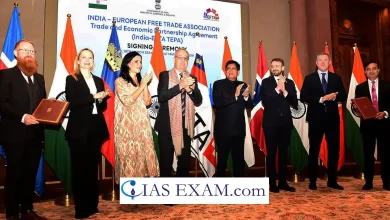Fulfilling the Potential of BIMSTEC
[GS Paper 2 – International Organization]
Context – The celebrations to mark the 25th year of the Bay of Bengal Initiative for Multi-Sectoral Technical and Economic Cooperation (BIMSTEC) have been accompanied by the announcement of several new initiatives.
The collective’s fifth summit that concluded in Colombo in the last week of March showcased member nations’ resolve to facilitate connectivity and security and enhance the prosperity of the region.
Key Developments of the 5th Summit:
- Although formed in 1997, the Charter of the Organization was finalized only recently. The 20-page document adopted at the fifth BIMSTEC Summit articulates the purpose, principles and legal standing of the organization.
- It also delineates the process to admit new members – this requires the consensus of the members. A similar procedure will be adopted for increasing the number of observer countries of the organization.
- One important provision in the charter is to keep regular meetings on track and provide enough scope to the BIMSTEC Permanent Working Committee to keep the process energized.
- It was envisaged that establishing an Eminent Persons’ Group (EPG) for formulating a vision document for the region will help in articulating the aspirations of the collective.
Establishment of BIMSTEC
- India had long felt that the vast potential of SAARC was being underutilized and opportunities were being lost due to either lack of response or because of an obstructionist approach from Pakistan. Thus, BIMSTEC was formed to overcome all such hindrances.
- The Bay of Bengal Initiative for Multi-Sectoral Technical and Economic Cooperation (BIMSTEC) is a regional organization comprising seven Member States: five deriving from South Asia, including Bangladesh, Bhutan, India, Nepal, Sri Lanka and two from Southeast Asia, including Myanmar and Thailand.
- This sub-regional organization came into being on 6 June 1997 through the Bangkok Declaration.
- In an effort to integrate the region, the grouping was formed in 1997, originally with Bangladesh, India, Sri Lanka and Thailand, and later included Myanmar, Nepal and Bhutan.
- BIMSTEC, now includes five countries from South Asia and two from ASEAN, is a bridge between South Asia and Southeast Asia.
Significance of BIMSTEC
- The Bay of Bengal is the largest bay in the world. Over one-fifth (22%) of the world’s population live in the seven countries.
- Despite economic challenges, all these seven countries have been able to sustain average annual rates of economic growth between 3.4% and 7.5% from 2012 to 2016. They have a combined GDP close to $2.7 trillion. It is the route for about 25% of global trade.
- India’s Multilateral regional engagement with BIMSTEC members will not only suffice India’s effort of boosting Blue Economy but will also provide comprehensive solutions for its maritime security, as diplomatic engagement with littoral nations will help nations in curbing various problems.
- BIMSTEC engagement is completely in consonance with the SAGAR Initiatives objective of increasing connectivity and development in North eastern states of India.
Challenges associated with BIMSTEC:
- BIMSTEC suffers from a lack of human and financial resources. India needs to allocate more resources to its BIMSTEC budget and should take an informal leadership role to provide BIMSTEC with momentum.
- India would have to counter the impression that BIMSTEC is an India dominated bloc, in that context India can follow the Gujral doctrine that intends to chalk out the effect of transactionary motive in bilateral relations.
- North Eastern states are of utmost importance in deepening connectivity among BIMSTEC nations, but Siliguri corridor that (chicken neck) provides a very narrow passage for movement, obstructs the connectivity.
- Underlying aspirations of China to be part of BIMSTEC, on the same lines as it harnesses a desire to be a permanent part of SAARC groupings, further aggravates the problem.
- The formation of another sub-regional initiative, the Bangladesh-China-India-Myanmar (BCIM) Forum, with the proactive membership of China, has created more doubts about the exclusive potential of BIMSTEC.
Way Forward
The pandemic has created fresh challenges and aggravated old ones in the countries of the region, particularly Sri Lanka and Nepal. India’s support to these countries, especially in financial matters, could help in reducing undesirable external intervention in the region. The region ‘s rife supply chain disruptions could well stave off further disruptions due to the efforts of the BIMSTEC.
As China mounts assertive activities in the Bay of Bengal region, with increased submarine movement and ship visits in the Indian Ocean, it is in India’s interest to consolidate its internal engagement among the BIMSTEC countries.





.png)



